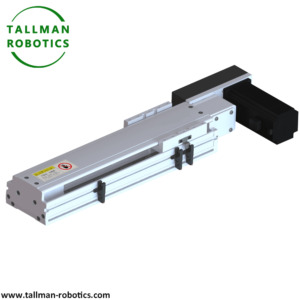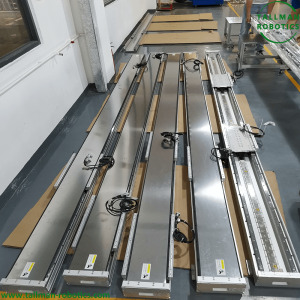#LinearMotors&Actuators
Explore tagged Tumblr posts
Text
Linear Actuators Robots

Linear Actuators Robots are a pivotal technology in modern robotics due to their versatility, precision, and scalability. They have a broad range of applications in various fields. Here's an overview of how Linear Actuators Robots are integrated into robotic systems and their benefits: Classification and Mechanisms: Types: Linear Actuators Robots can be driven by different mechanisms including screw type, belt drives, and linear motors. Each mechanism offers unique advantages; for instance, screw-based actuators driven by stepping motors are highly suitable for precise positioning but may be underpowered for certain applications requiring servo motors. Motion and Force: These actuators provide both horizontal and vertical motion. They can handle travel distances up to 500 feet and speeds up to 600 inches per second, and manage loads up to 10,000 pounds, making them suitable for a variety of industrial applications. Applications: Manufacturing Automation: Linear Actuators Robots are prominently used in automation for repetitive, tedious, or dangerous tasks. They help in streamlining processes and maintaining high precision and consistency in manufacturing, greatly reducing production costs. Prosthetics: The introduction of micro linear actuators has revolutionized prosthetics, enabling more natural and powerful motions in prosthetic hands. These tiny actuators offer significant strength and precision, essential for driving individual fingers directly. Drones and Aerospace: In drones, actuators are used for functions such as camera gimbals, retractable landing gear, and arms for manipulating objects. They are also incorporated into aerospace applications, such as the International Space Station, demonstrating their reliability and precision in high-stakes environments. In conclusion, Linear Actuators Robots are vital components in the development of robotic systems, offering a broad spectrum of applications from industrial automation to advanced prosthetics and space exploration. Their adaptability, precision, and robustness make them indispensable in advancing robotics technology into the future. Here, we introduce our Screw drive linear modules by model TMS45 semi-closed type for general environment.






You are welcome to watch more projects or visit our website to check other series or load down e-catalogues for further technical data. Youtube: https://www.youtube.com/@tallmanrobotics Facebook: https://www.facebook.com/tallmanrobotics Linkedin: https://www.linkedin.com/in/tallman-robotics Read the full article
#ActuatorsinCartesianRobot#AutomationandRoboticswithElectricLinearActuator#Cartesianrobotic#Electriclinearactuators#IndustrialRobotslinearactuators#inearActuators#LinearActuator#Linearactuatorrobots#LinearActuatorsforRobotics#LinearMotionandActuatorsforSurgicalRobotics#Linearmotorsingleaxisrobots#LinearMotors&Actuators#Linearrobots#MicroLinearActuators#MultiStationBeltLinearActuator2AxisRobot#PrecisionLinearActuators#RobotActuators#RobotLinearActuators#RoboticArmwithLinearActuators#roboticslinearactuator#SingleAxisRobotLinearActuators#SingleAxisRobots#XYActuator(SingleRail)
0 notes
Text
youtube
Introduction LINAX® Lxu F60S: Precise Linear Motion Solution - Key Features https://www.youtube.com/watch?v=Qu3zm8G6XR4 Discover the LINAX® Lxu F60S from Jenny Science AG, a high-precision linear actuator designed for industrial automation applications. Visit our website for more: https://ift.tt/DN9JUts This innovative device combines cutting-edge technology and Swiss precision to deliver fast, silent, and highly accurate linear motion, making it an ideal solution for automated systems and demanding industrial environments. Explore its advanced features, compact design, and versatile mounting options. Learn how the LINAX® Lxu F60S integrates seamlessly into various industrial applications and why it’s the perfect choice for precise, repeatable motion to enhance your automation system’s efficiency. Don't forget to subscribe, like the video, and leave your comments for more information about industrial technology and automation. The video is about: Introduction to LINAX® Lxu F60S: Precise Linear Motion Solution – Key Features This video covers the following topics: Key features of the LINAX® Lxu F60S linear actuator Benefits of automation with Swiss precision Technology Integrating linear actuators into industrial systems Introduction LINAX® Lxu F60S: Precise Linear Motion Solution - Key Features ✅ Chapters: 00:00 Introduction LINAX® Lxu F60S 00:15 Single Cable Solution 00:20 Absolute Measuring System 00:25 Four through-holes in the carriage 00:35 Compact Dimensions ✅ Subscribe To Our Channel For More Videos: https://www.youtube.com/@JennyScienceAG/?sub_confirmation=1 ✅ Important Link: 👉 Website: https://ift.tt/DN9JUts 👉 Product: https://ift.tt/mBToQ6W ✅ Stay Connected With Us: 👉 LinkedIn: https://ift.tt/KPCjtIV 👉 Facebook: https://ift.tt/REeagSA ============================== ✅ Other Videos You Might Be Interested In Watching: 👉 Jenny Science - LINAX® Lxs F60S https://www.youtube.com/watch?v=SyFWXBQiTzA 👉 Jenny Science - Motion Control over EtherCAT https://www.youtube.com/watch?v=Qk8SO5hlkKk 👉 Jenny Science - Pick and Place rotating Finale https://www.youtube.com/watch?v=pn0wuqfxGig 👉 Jenny Science - Gantry: Simplified Assembly & Enhanced Precision https://www.youtube.com/watch?v=jzppnUSqErY ============================= ✅ About Jenny Science AG: As an ambitious, internationally active family business, Jenny Science AG is today a leading component manufacturer for industrial automation. With around 65 employees at our headquarters in Rain (LU), we develop and manufacture compact linear motor axes, linear motor slides, hollow shaft motors and intelligent, web-based motor controls for demanding customers all over the world. For collaboration and business inquiries, please use the contact information below: 📩 Email: [email protected] 🔔 Subscribe to our channel for more videos: https://www.youtube.com/@JennyScienceAG/?sub_confirmation=1 ===================== #linax #linaxlxuf60S #jennyscience #linearmotor #linearactuator #industrialautomation #linearmotion #precisionactuator #motioncontrol © Jenny Science AG via Jenny Science AG https://www.youtube.com/channel/UCjWsIm0BVRObYMt9nmyn6ww December 05, 2024 at 08:13PM
#jennyscience#ethernetinstaller#xenaxcontrollers#webmotion#motorcontrol#servocontroller#industrialautomation#motorcontroltechnology#Youtube
0 notes
Text
Linear Motor Actuators Will be Delivered to Germany

Linear Motor and Actuators from Tallman Robotics Will be Delivered to Germany.

Here are some details about linear servo motor modules: 1. Types of Linear servo Motors: Linear motor modules can be categorized into different types based on their design and configuration: - Single-Axis Linear Motors: These actuators provide linear motion along a single axis. They are commonly used for applications that require linear positioning or pushing/pulling tasks. -Multi-Axis Linear Motors: These actuators consist of multiple linear motors combined in a coordinated manner to provide motion in multiple axes. They are used in applications that require precise and synchronized movements in different directions, such as robotics or multi-axis machining. - Planar Linear Motors: Planar linear motor modules are designed to provide motion in a two-dimensional plane. They can offer linear motion in both X and Y axes, making them suitable for applications such as gantry systems or XY tables. - Curved Linear servo Motors: Curved linear motor modules are designed to provide linear motion along a curved path. They are used in applications that require motion along curved surfaces or tracks, such as in packaging or material handling systems. 2. Feedback Systems: Linear motor actuators often incorporate feedback systems to provide accurate position control and feedback information. These feedback systems can include optical encoders, linear scales, or Hall effect sensors. The feedback signals are used by the control system to ensure precise positioning and closed-loop control of the actuator. 3. Control Options: Linear motor actuators can be controlled in various ways depending on the application requirements. They can be controlled manually using switches or buttons, or they can be integrated into automated control systems. Automated control options include using programmable logic controllers (PLCs), motion controllers, or computer-based control systems. These control systems allow for precise control of motion parameters such as speed, acceleration, deceleration, and position. 4. Environmental Considerations: Linear motors can be designed to meet specific environmental requirements. For example, they can be built to withstand harsh conditions such as extreme temperatures, humidity, or exposure to dust or chemicals. This makes them suitable for applications in industries such as automotive, aerospace, or manufacturing where environmental conditions can be challenging. 5. Integration with Other Systems: Linear motors can be easily integrated with other systems or components to create complete motion solutions. They can be combined with mechanical components such as guide rails, bearings, or couplings to ensure smooth and precise linear motion. Additionally, they can be integrated with control interfaces, communication protocols, or network systems to enable seamless integration into larger automation systems. 6. Safety Considerations: Safety features can be incorporated into linear motor actuators to ensure safe operation. These features may include emergency stop buttons, limit switches to prevent overtravel, position sensors for accurate positioning, or torque sensing to detect abnormal loads or obstructions. 7. Cost Considerations: The cost of linear motors can vary depending on factors such as the type of linear motor used, the size and load capacity of the actuator, the level of precision required, and additional features or customization. It is essential to consider the specific application requirements and balance them with the associated costs to determine the most suitable linear motor actuator solution. You are welcome to https://www.youtube.com/@tallmanrobotics to watch our video centre for more projects or visit our website to check other series or load down e-catalogues for further technical data. Read the full article
#ElectricLinearActuators#LinearDCmotors#Linearmagneticmotorsandactuators#LinearMotorActuator#LinearMotorActuators#Linearmotorsingleaxisrobots#LinearMotors&Actuators#motorisedlinearactuator#StepperMotorLinearActuators#TubularLinearMotors
0 notes